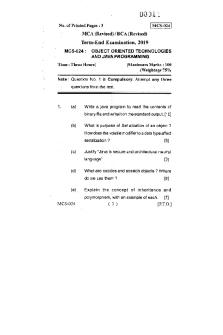June 2019 501H3 - Question Paper PDF

| Title | June 2019 501H3 - Question Paper |
|---|---|
| Course | Computational Fluid Dynamics |
| Institution | University of Sussex |
| Pages | 3 |
| File Size | 140 KB |
| File Type | |
| Total Downloads | 369 |
| Total Views | 840 |
Summary
Candidate Number501HTHE UNIVERSITY OF SUSSEXMSc and MEng ( year 4 ) EXAMINATION 2019 May/June 2019 (A2)COMPUTATIONAL FLUID DYNAMICSAssessment Period: May/June 2019 (A2)DO NOT TURN OVER UNTILINSTRUCTED TO BY THE LEADINVIGILATORCandidates must attempt THREE out of FOUR questionsDuration: 2 hoursIf all...
Description
Candidate Number
501H3
THE UNIVERSITY OF SUSSEX MSc and MEng (year 4) EXAMINATION 2019 May/June 2019 (A2)
COMPUTATIONAL FLUID DYNAMICS Assessment Period:
May/June 2019 (A2)
DO NOT TURN OVER UNTIL INSTRUCTED TO BY THE LEAD INVIGILATOR Candidates must attempt THREE out of FOUR questions Duration: 2 hours If all four questions are attempted, all will be marked, but the lowest mark will not be counted in the total for the paper. At the end of the examination the question paper and any answer books/answer sheets, used or unused, will be collected from you before you leave the examination room. Examination handout: None
501H3
1.
COMPUTATIONAL FLUID DYNAMICS
Below a 2-dimensional finite volume mesh is shown. The mesh is structured and equidistant. The flow variables (𝜌, 𝑢, 𝑣, 𝑝) are stored at the mid points of cells (𝑃, 𝑊, 𝐸, 𝑁, 𝑆). Derive the following terms for the cell with the midpoint P, using the flow variables at the at the mid points of cells
a. the total mass flux into the cell [5 marks] b. the total x-momentum flux due to convective transport (i.e. due to the bulk flow) into the cell [5 marks] c. total pressure force acting on the cell in x-direction [5 marks] d. accumulation of x-momentum in the cell [5 marks]
2. a. What difficulties would arise if a density-based CFD code is used to simulate a low Mach number flow field? [4 marks] b. Explain the differences between Reynolds Averaged Navier Stokes (RANS) simulations, Large Eddy simulations (LES) and Direct Numerical simulations (DNS). [6 marks] c. Derive the Poisson equation for pressure from the incompressible flow equations given below. 𝜕𝑢𝑗 =0 𝜕𝑥𝑗 𝜕𝜌𝑢𝑖 𝑢𝑗 𝜕𝜏𝑖𝑗 𝜕𝑝 𝜕𝑢𝑗 =− + − 𝜕𝑡 𝜕𝑥𝑖 𝜕𝑥𝑖 𝜕𝑥𝑗 [10 marks]
2
501H3 3.
COMPUTATIONAL FLUID DYNAMICS The steady-state convection-diffusion equation for a 1-dimensional system is given as: 𝜕(𝜌𝑢𝜙) 𝜕𝜙 𝜕 = (𝜇 𝜕𝑥 ) 𝜕𝑥 𝜕𝑥 Answer the following questions to solve this equation numerically using the equi-distant mesh shown below:
a. Determine the discretised form of the convective term using 1st order Forward Differencing Scheme [5 marks] b. Discretize the diffusive term with 2nd order Central Differencing Scheme [5 marks] c. Show how to implement the Dirichlet boundary conditions: 𝜙 = 0 𝑎𝑡 𝑥 = 0 and 𝜙 = 1 𝑎𝑡 𝑥 = 1 [5 marks] d. Explain briefly how you can solve the obtained algebraic equation set. [5 marks]
4. a. Explain the “law of the wall” with the help of a figure. [7 marks] b. Explain how the law of the wall can be used to formulate “wall functions”. [5 marks] c. What are the advantages and disadvantages of wall functions? [8 marks]
End of paper
3...
Similar Free PDFs

June 2019 501H3 - Question Paper
- 3 Pages

COS3711 June 2020 question paper
- 5 Pages

June 2019 Language Paper 2
- 2 Pages

Mark Plan June 2019 - Exam June 2019
- 16 Pages

NEET-2019 (Code-P1) Question Paper
- 20 Pages

Automotive Quiz June 2019
- 30 Pages

2019 May\\June Exam
- 4 Pages

MAF201 - JUNE 2019 - test
- 7 Pages

IPL June 2019
- 4 Pages

Solution TAX667 JUNE 2019
- 7 Pages

Final June 2019, answers
- 11 Pages

Exam June 2019, questions
- 12 Pages

FIN320 - JUNE 2019
- 10 Pages
Popular Institutions
- Tinajero National High School - Annex
- Politeknik Caltex Riau
- Yokohama City University
- SGT University
- University of Al-Qadisiyah
- Divine Word College of Vigan
- Techniek College Rotterdam
- Universidade de Santiago
- Universiti Teknologi MARA Cawangan Johor Kampus Pasir Gudang
- Poltekkes Kemenkes Yogyakarta
- Baguio City National High School
- Colegio san marcos
- preparatoria uno
- Centro de Bachillerato Tecnológico Industrial y de Servicios No. 107
- Dalian Maritime University
- Quang Trung Secondary School
- Colegio Tecnológico en Informática
- Corporación Regional de Educación Superior
- Grupo CEDVA
- Dar Al Uloom University
- Centro de Estudios Preuniversitarios de la Universidad Nacional de Ingeniería
- 上智大学
- Aakash International School, Nuna Majara
- San Felipe Neri Catholic School
- Kang Chiao International School - New Taipei City
- Misamis Occidental National High School
- Institución Educativa Escuela Normal Juan Ladrilleros
- Kolehiyo ng Pantukan
- Batanes State College
- Instituto Continental
- Sekolah Menengah Kejuruan Kesehatan Kaltara (Tarakan)
- Colegio de La Inmaculada Concepcion - Cebu


